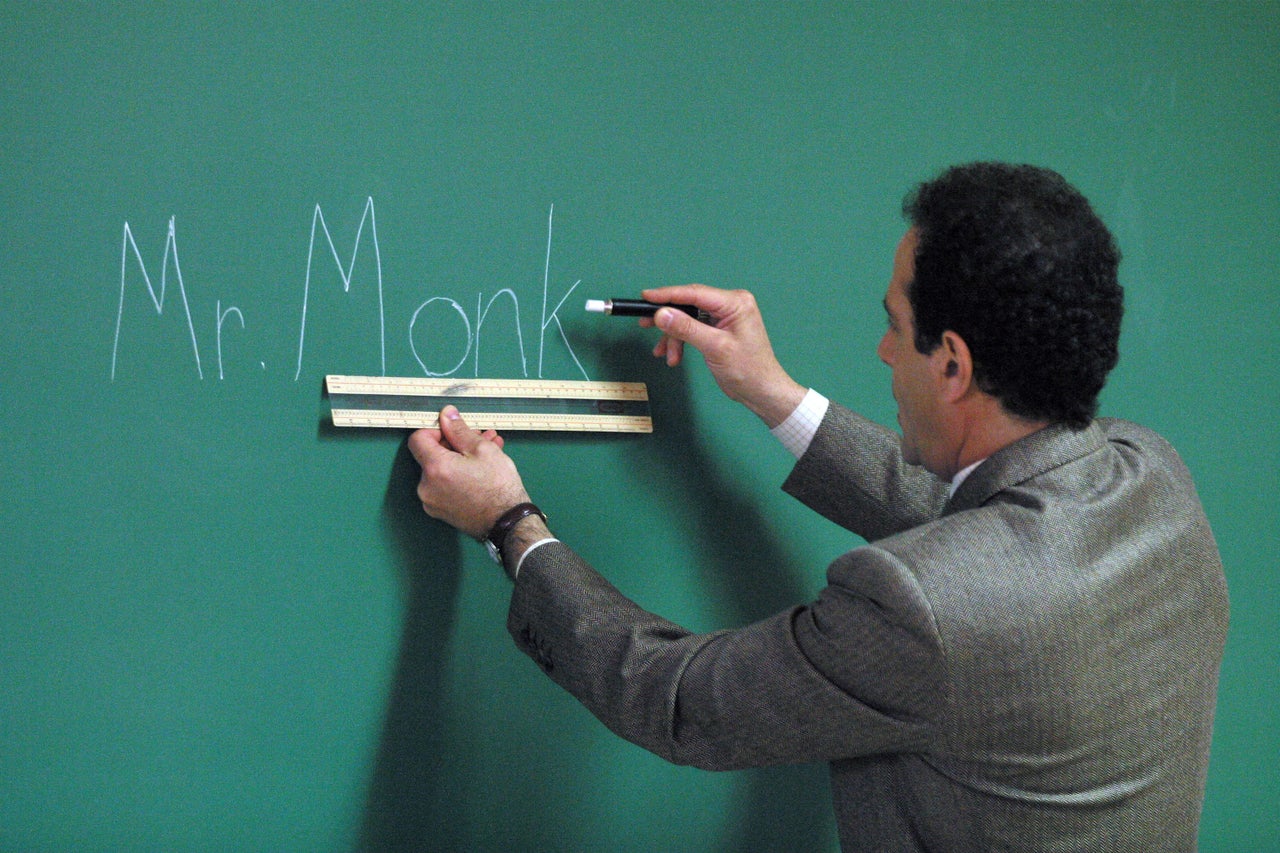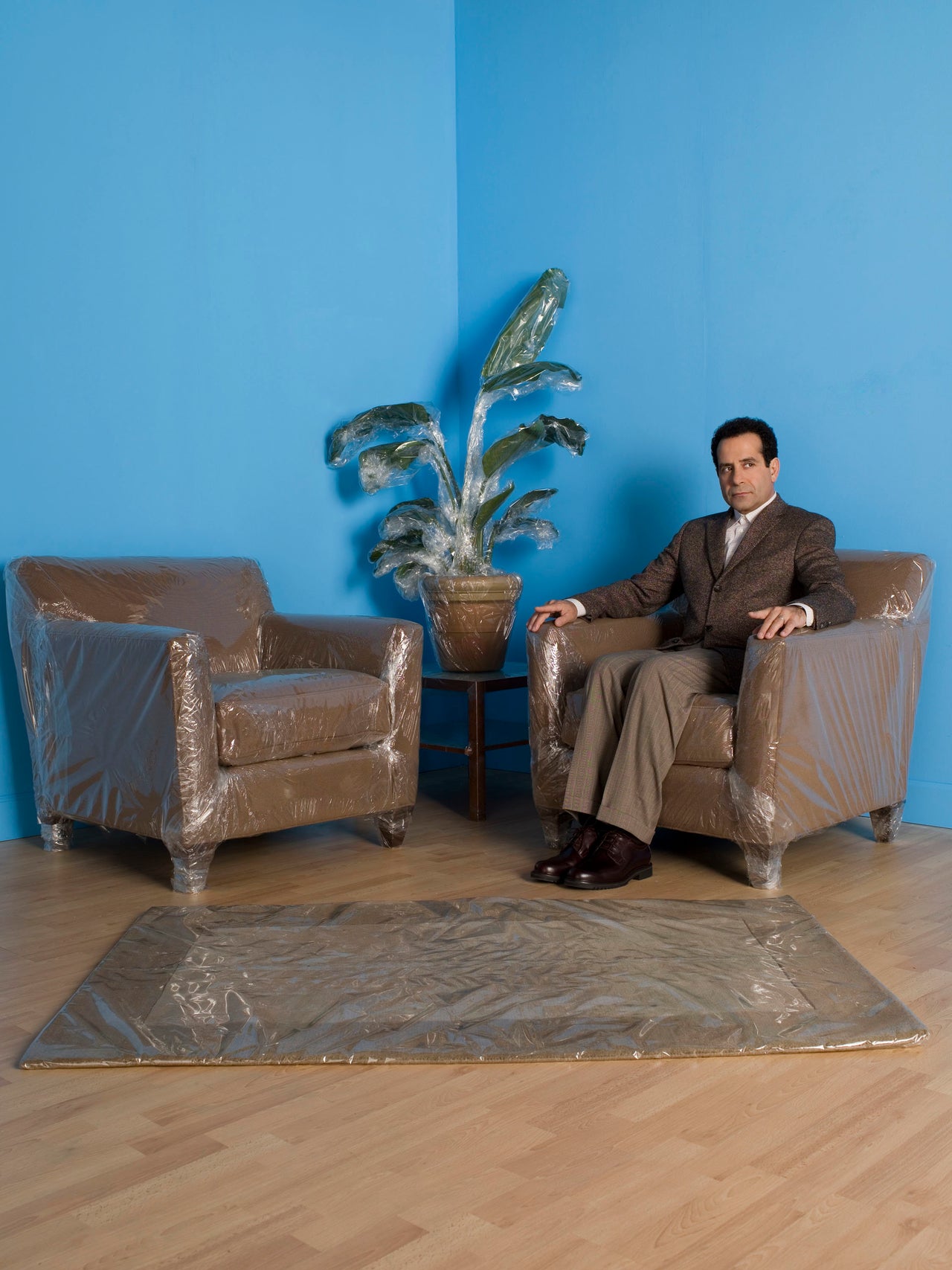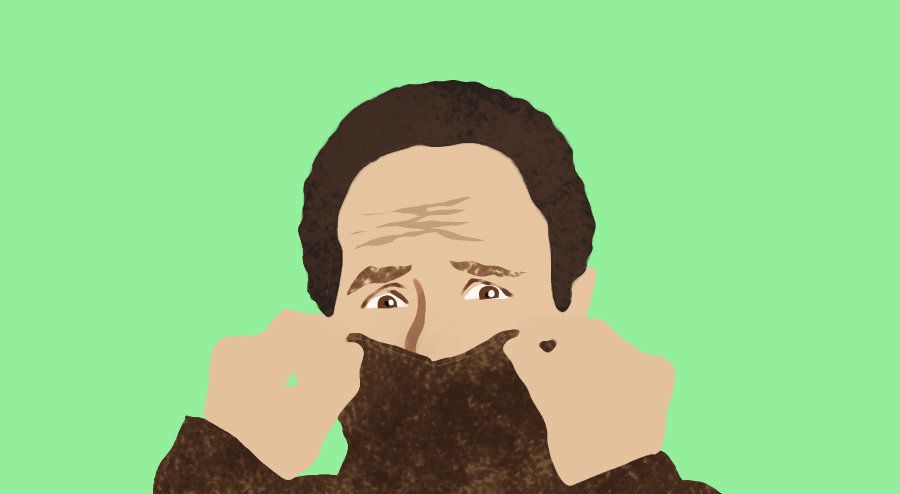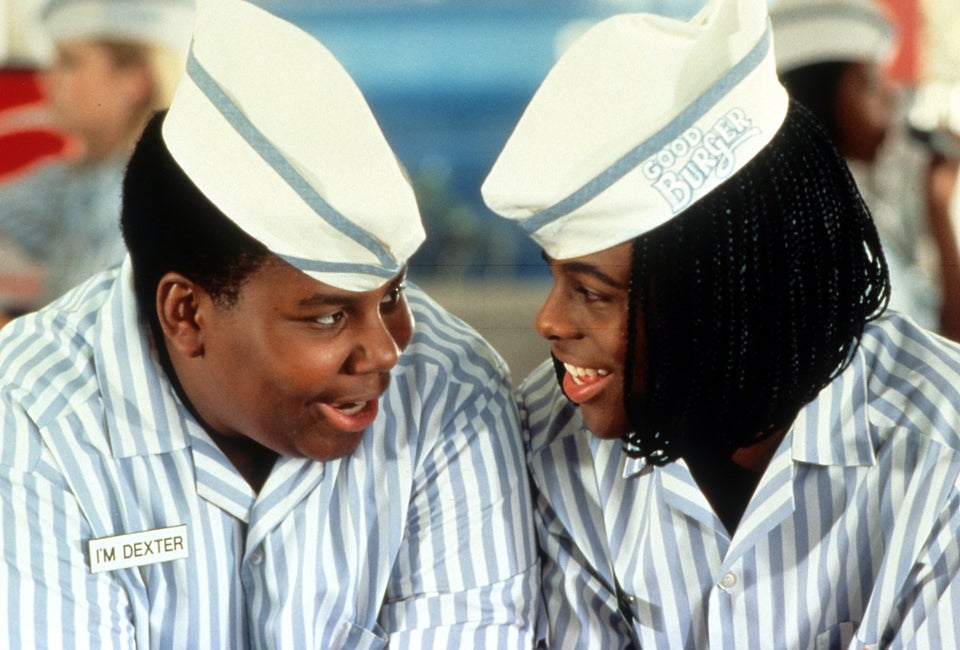A woman is found dead. Hanged from a noose in her own home. The cause of death seems to be suicide, but Detective Adrian Monk suspects murder.
Specifically, he believes the murderer to be the woman’s ex-boyfriend, an astronaut and national hero on the precipice of running for public office. The only problem? The astronaut was orbiting in space at the alleged time of her death. But Monk remains undeterred and, of course, he’s always right. The only question remaining: How’d the astronaut do it?
This setup ― a carefully crafted, totally absurd, almost-but-not-quite-perfect murder ― is typical of “Monk,” the USA crime comedy that premiered 15 years ago today.
The show stars Tony Shalhoub as Monk, a private consultant whose exhaustive list of phobias and compulsions proves challenging in many aspects of daily life but quite handy when it comes to crime solving. In his heyday, Monk worked with the San Francisco police force, until his beloved wife Trudy was murdered and his already burdensome anxiety spiraled into obsessive-compulsive disorder.
One year after Trudy’s murder (the only case Monk couldn’t solve ― until the series finale, that is), Monk’s OCD subsumes his ability to work functionally as a cop, and he is forced to give up his badge. Yet, along with the disorder’s more debilitating symptoms ― social anxiety, excessive hygiene habits and a crippling fear of milk, to name a few ― come useful eccentricities for the fictional Monk: including a preternatural attention to detail and a profound ability to see what others cannot.
Thus Monk becomes the go-to private detective, tasked to handle high-profile and utterly bizarre cases the police can’t solve. Like, for instance, a case involving a man who somehow killed his lover while the rest of the country watched him running a marathon at the time of the murder. Or one involving a victim on death row, killed hours before his scheduled execution. Or how about the 800-pound man who hadn’t left his bed for 11 years yet managed to slay a judge he so openly despised?
These are not crimes you’re likely to see recounted on the nightly news, because crimes like this hardly, if ever, occur in real life. “The creators of ‘Columbo’ would refer to their series as a fantasy, and that’s how I see our show,” Andy Breckman, the co-creator of “Monk,” told HuffPost in a phone conversation. “Monk was solving crimes in contemporary America and he never once collected DNA, he never once used a computer. We lived a in a little bubble we created.”
Breckman referred to the specific kinds of mysteries employed in the show as “impossible crimes” or “locked-room mysteries.” He explained, “In ‘Monk’ you often know ‘whodunit’ very early on. Monk will know who the killer is, he just can’t figure out how he did it or why. The stories we wrote were high-concept, low-tech puzzle mysteries.”

Breckman, a sketch comedy writer who’d worked on shows like “Saturday Night Live” and “Late Night with David Letterman,” was having lunch with producer David Hoberman one day when Hoberman pitched the idea: A series about a detective with OCD.
“I knew immediately the idea was perfect for me because it was a chance to marry my great passions — mysteries and comedy,” Breckman, who grew up on Agatha Christie and Arthur Conan Doyle, said. “Until David Hoberman dies, I have to give him credit for the idea,” he added.
Hoberman’s idea ― the “obsessive-compulsive detective” as billboards would eventually read ― wasn’t totally out of the blue. As a child, Hoberman lived with OCD and various phobias. And as an adult, he served on the board of the Anxiety Disorders Association of America.
“[Hoberman] didn’t see it as a big joke,” Shalhoub told HuffPost. “He wanted to make sure we were being somewhat respectful to the people who struggle with this disorder. Trying to find the comedy without turning it into a mockery.”
At the time, though, Breckman wasn’t all that worried about the nuances of creating a television character with a mental health disorder or the potential for insensitivity or exploitation such a character might pose. He considered Monk’s disorder, like the rest of the show, grounded in make-believe, not reality. “The cluster of symptoms that Adrian Monk had did not exist in any human being,” Breckman said. “It was malleable, it was a fantasy.”
Monk’s character was created to generate comedy and compassion, not to teach viewers about the authentic experience of living with mental illness. Like the crimes that take place onscreen, Monk’s symptoms are imagined, exaggerated and oftentimes farcical, taking commonly conceived manifestations of the disorder and folding them into a sort of experimental theater.
And yet, in large part thanks to Shalhoub’s acting chops, what could look cartoonish or offensive often comes off as an embellished portrayal of something subtle and true. It’s tempting to wonder, would a show like “Monk” be made today?
“People are more sensitive today than they were 15 years ago,” Breckman said. “The internet was not what it is now, Twitter was not what it is. I was in my own little world.”
At the very least, people today have access to more platforms upon which they can express opinions on the way mental illness is ― or isn’t ― authentically presented on TV. Characters with mental illness are underrepresented across the entertainment landscape, and most often, representations of disorders like OCD fail to challenge the stereotypes and stigmas associated with them. For example, before Lena Dunham’s portrayal of Hannah Horvath on “Girls,” few actors had explored the way OCD could be portrayed onscreen ― without an agenda or a punchline.
As Breckman readily admits, the televised depiction of Monk’s disorder is far from medically accurate. One writer for Psychology Today wrote a piece in 2013 condemning a particularly questionable episode in which Monk begins taking medication and loses his essential Monk-ness as a result. Eventually his squad ― Captain Leland Stottlemeyer, Lieutenant Randy Disher and nurse Sharona Fleming ― insists he give up the meds lest he lose his detecting abilities, a dangerous conclusion for the many people who rely on psychiatric medication to function healthily.
And yet perhaps because of the dire lack of onscreen visibility for individuals experiencing mental illness, an overwhelming number of viewers were excited to watch a show starring a hero living with OCD. “It’s very funny,” Patricia Perkins, the former executive director of the Obsessive-Compulsive Foundation told Variety in 2008. “I have OCD, and that’s my sense of humor.”
Shalhoub told HuffPost that he still receives letters thanking him for playing Monk to this day, eight years after the show’s final season. For those letter-writers, there was something powerful about a character who openly struggled with mental illness and was exceptional at his job nonetheless.
“We didn’t set out to change the world here,” Shalhoub said. “We never thought of ourselves as The Learning Channel; we knew what we were doing was entertainment. But it seemed to have some kind of impact, and that’s heartening.”

Surely part of what drew so many viewers to “Monk,” regardless of their own mental health experiences, was Shalhoub’s performance, for which he won three Emmys. It’s nearly unfathomable to think that Breckman and Hoberman originally wrote the pilot episode of “Monk” with Michael Richards ― yes, Kramer ― in mind.
Richards passed on the role, and eventually the pilot script wound up in the hands of Shalhoub’s manager, who strongly suggested that he take a look. The role, Shalhoub recalled, was different then, more of a “modern-day Inspector Clouseau” with heavy reliance on quasi-clownish, physical comedy. Upon first read, Shalhoub couldn’t quite picture himself as Monk. “I liked the material, but I didn’t really see myself in it,” he said.
When Shalhoub delivered the news to his manager, she was unrelenting. “You need to read it again. It’s more like you than you even know,” she said. And so he did.
When Shalhoub agreed to take on the part of Monk, it changed shape somewhat ― became darker, more fragile. “I knew I wanted the comedy to grow out of the pain,” Shalhoub said. This notion that Monk’s strengths are inextricably bound up with his trauma resulted in comedic moments that make viewers laugh even as their hearts ache.
To learn more about obsessive-compulsive disorder before filming began, Shalhoub paid visits to a Los Angeles psychiatrist who worked primarily with patients with OCD. Shalhoub absorbed real people’s stories through news articles and nonfiction TV shows like “Dateline NBC,” taking in the ways OCD affected and often disrupted people’s lives. “It kept us in check. We never wanted to make it too lightweight,” he said.
Yet OCD is not the only distinctive quality that separates Monk from other television protagonists. Monk is an unusual, if not unprecedented hero, not so much for his brilliance but for his vulnerability and fragility ― what Shalhoub referred to as a “childlike innocence.”
There have been plenty of misanthropic male geniuses on TV, from “House” to “Sherlock,” who can’t help but deliver their astute conclusions with a dash of cruelty and condescension. Monk, however, is unwaveringly gentle, awkward and kind. Sure, he occasionally offends a stranger or aggravates the hell out of his colleagues, but Monk’s social gaffes come from a place of anxiety rather than malice, insecurity not ego. Even when wrestling a gun from a murderer’s grip, Monk is mild and soft. His courageous undertakings are all the more remarkable because of how openly terrified at the prospect of them he is. He’s not just scared of the gun, but the gun wielder’s sweaty hands, mis-buttoned shirt and smacking gum.
In every episode, Monk encounters countless banal obstacles on his journey to cracking a case, from shaking hands with someone post-sneeze to gazing upon a light bulb flickering on and off. The show spends ample time luxuriating in these moments of mundane panic, lapsing into short, silent films with Monk as a Buster Keaton-esque sad clown, moving through the world with his own eccentric rituals. During such moments, a familiar soundtrack plays as Monk opts out of the functioning world around him to straighten a lopsided antenna or remove a smudge from an otherwise clean surface.
The particulars of Monk’s behaviors, Shalhoub explained, came to him the first day on set, almost psychically. They were filming the first scene of the pilot, in which Monk and the police were scouring a fresh crime scene for clues. In between shots writer Dean Parisot asked Shalhoub what he thought about a lamp that was sitting on a nearby desk. Shalhoub responded, as anyone might: “I don’t know, what are you talking about?”
“Would you like to touch that lamp?” Parisot asked. Shalhoub gave it a shot and lightly brushed his finger against the lampshade’s edge.
“In that one second, it was like almost like an electric shock, I can’t describe it,” Shalhoub recalled. “It was as if the character just came to me in that second. I got into his skin. A wave just came over me and it became a kind of defining moment. And then, interestingly, over the next eight years, Monk couldn’t go by any kind of lamp without touching it. And if he couldn’t touch the lamp, he would focus very heavily on it, wanting very badly to touch it.”
Shalhoub’s subtle acting choices were key to the show’s success. As Jason Gray-Stanford, who played Lieutenant Randy Disher, said, “The show is called ‘Monk’ for a reason.’” The humanity Shalhoub brings to the role makes his most outlandish outbursts feel utterly relatable ― we all have little things that drive us wild, small hurdles that make every day a struggle, fears and insecurities we’re ashamed to name out loud.

Yet the appeal of “Monk” is also bound up in the irresistible draw of the mysteries themselves, which instill a childlike wonder in viewers of all ages with their old-fashioned, follow-the-breadcrumbs intrigue. To help craft the show’s playful and convoluted crimes, Breckman brought in mystery writer Hy Conrad, after stumbling upon his book of short mysteries for kids, Almost Perfect Murders.
Conrad credits his love of mysteries to Agatha Christie’s The Murder of Roger Ackroyd, which “blew his mind” with its final twist. With his own mysteries, Conrad hopes to achieve a similar outcome of astounding the viewer while still playing fair. “There needs to be a fair match between reader and writer,” Conrad specified. “The clues have to be right there in front of you, but at the same time, you’re messing with people’s assumptions. You’re trying to trick them.”
Let’s return to the aforementioned astronaut case as an example. How did an astronaut murder his ex while simultaneously floating through space? Well, he visited her apartment before liftoff and spiked her drinks with enough drugs to knock her out for a few days. Then he tied a noose around her neck as she lay unconscious, attaching the end of the rope to a rigged garage door. Next, he takes the garage door opener (whose button he’s taped down) and sticks it inside a doll, which he then mails to the ex’s house using two-day shipping. When the package arrives, it triggers the garage to open, effectively hanging the woman while her former lover is orbiting the planet.
Not the easiest mystery to solve, but it’s possible. Technically. “Monk” transformed crimes into macabre Rube Goldberg machines, devising completely absurd means of killing that were at once kind of laughable and kind of beautiful. It’s difficult for most of us to conceive of our own deaths; to imagine what it would feel like to leave the world. The extraordinary murder plots in “Monk” are equally inconceivable. So what’s more difficult to wrap your head around: that you could one day cease to exist, or that a cunning killer made a mold of his neighbor’s dog’s mouth to serve as an untraceable murder weapon? A fantastic death ― is there any other kind?
One of Breckman’s favorite episodes is called “Mr. Monk Goes Back to School,” in which Monk believes a married teacher murdered his co-worker, with whom he’d been having an affair, despite the fact that he was teaching an entire classroom of students when her body fell from the top of a clocktower on campus.
How’d he do it? The teacher killed the woman at the top of the clocktower. Then he placed her lifeless corpse on the massive clock’s giant minute hand before it was parallel to the ground, ahead of the 15-minute mark. When the minute hand tick-tocked its way to a downward slope, the woman’s body slipped off and crashed to the ground below, setting off a car alarm just as the teacher had secured his perfect alibi.
“I can brag about this episode because it wasn’t my idea,” Breckman said. “To me, a resolution like that is as elegant and beautiful as a sonnet by Keats. It is genius.”

One can imagine how, with plot lines such as these, murder ― conducted with savvy, gusto and imagination ― could be thrilling but not disturbing. Breckman had a specific set of guidelines in place to ensure that all “Monk” slayings were of the family-friendly variety ― to the extent that such a thing is possible. “No children were ever in danger,” he said, listing off his criteria. “We never dealt with rape. We never had a psychotic serial killer. Our villains were not twisted and dark villains. They were often wealthy, successful men who killed their mistresses.”
Are killers more comforting when they’re rich dudes offing the women they’re intimately involved with? Well, no. Definitely no. But for the most part, within the parameters of the show, more attention is paid to the mechanics of the murder than the motivation behind it. That disgruntled husbands, wives, mistresses and misters throughout San Francisco spend sleepless nights devising intricate plots to kill one another is virtually accepted as fact.
This unusual recipe for family-friendly murder proved successful for “Monk,” which prided itself on its ability to appeal to all ages at once. (The show’s finale set a cable ratings record with 9.4 million viewers.) “Three generations could watch it together, and each get it on a different level,” Shalhoub said. “There wasn’t any graphic language, no adult content. We felt good about that. We were the un-hippest show in television. We reveled in our un-hipness.”
The show’s squeaky clean tenor extended past its treatment of violence and profanity. It went light on sexuality, too. In fact, Shalhoub maintains a theory that Monk is still a virgin. “I always had this fantasy that Monk and Trudy had a plan to consummate their marriage the day that she was killed, and it never happened,” Shalhoub said, adding that most other cast and crew members do not buy into his hypothesis.
The virgin theory may be a stretch, but it does fit with the adolescent trepidation Monk displays in so many of his human interactions ― romantic or otherwise. When engaging with strangers, potential cold-blooded killers or not, Monk fidgets incessantly, wriggling his fingers and tugging at his collar, not unlike a kid at a middle school dance.
Shalhoub believes the character’s pubescent tenor helped the show resonate with a younger audience, who also felt uncomfortable in their own skin. “There is a certain age group that really identifies with Monk, I’ve found,” Shalhoub said. “People around the age of 14 or 15. I think it’s because they’re transitioning from childhood to adulthood, with a foot in both worlds and a foot in neither. That’s how I thought of Monk, as someone who is not really in the world that everyone else is in. He is walking alongside of it, in a way.”

Shalhoub proposed one final theory when contemplating viewers’ unlikely rapport with Detective Monk. The show premiered July 12, 2002, less than a year after September 11, 2001. On a certain level, Shalhoub thinks the national panic that followed the terrorist attacks made everyone feel on edge, even amid their own comfortable routines. “I think on some subliminal level we were in an age of anxiety,” he said. “Everyone was trying to go about their lives as usual, but things were different. And here you have a character who lives in a constant state of fear.”
Many Americans, Shalhoub believes, identify with a character for whom the everyday rituals of leaving one’s home, going to work and interacting with friends are laced with dread. At least in Monk’s world, we can rest assured that by the end of the 45-minute episode, the killer will be identified, justice will be served and order will be restored.
For Monk, disorder and danger are one and the same. Every day is littered with potential for disaster, whether administered by a murderous husband or a leaky faucet, an elevator, dust, chalk, rodeos, egg whites, dentists or cats. As the show’s theme song goes, “People think I’m crazy, ’cause I worry all the time. If you paid attention, you’d be worried too. You better pay attention, or this world we love so much might just kill you.”
Watching Monk, one gets the sense that in each episode, the detective’s biggest triumph isn’t solving the case but simply making it trough the day. Whether battling OCD, anxiety or depression, low self-esteem or fatigue, that’s something most viewers can identify with.
″‘Monk’ was a show about small victories,” Shalhoub said. “Is this character going to get completely better? Probably not. But he will solve this puzzle. He will help this person or that. It’s not everything but its’ something. People want to feel like it’s not all bad all the time.”
On the surface, “Monk” is one of the more unique and outlandish characters to grace television screens, but the core aspects of his personality are ultimately relatable, if not universal. Who hasn’t felt horribly awkward and inept while making small talk with a group of new people? Or overwhelmed and exhausted by the banal worries that pop up during a day’s work? Who hasn’t felt fundamentally different? Feared they’d never be truly accepted, understood or loved for who they are?
Or ― at the very least ― who hasn’t feared being murdered through a bizarre, convoluted and untraceable chain of events? And in the face of such a deep and uncontrollable sense of dread, felt the urge to laugh?


Hit Backspace for a regular dose of pop culture nostalgia.
CORRECTION: A previous version of this article misidentified the victim of “Mr. Monk Goes Back to School” as the murderer’s wife. She was his mistress. A previous version of this story also indicated that in one episode off the show, a killer made a mold of his dog’s mouth to serve as a murder weapon. In fact, it was his neighbor’s dog.

